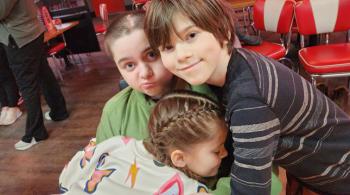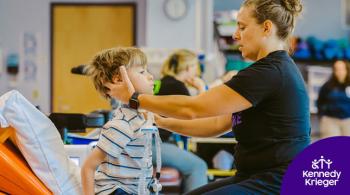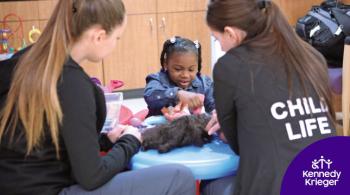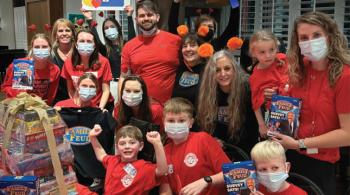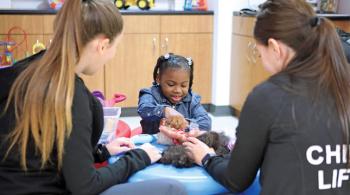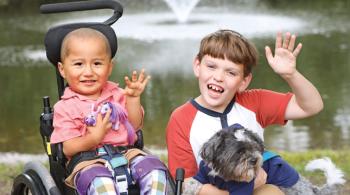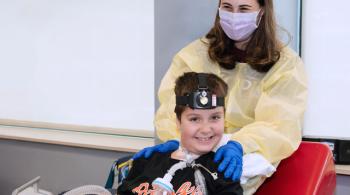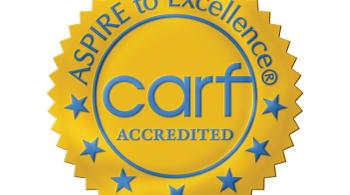By Laura Thornton
Ellie, 15, has a severe form of Marfan syndrome, a disorder of the body’s connective tissue, the glue that holds the body together. She’s had more than 20 surgeries—primarily to her eyes, heart, spine and legs—but it wasn’t until 2018 that Ellie followed surgery with inpatient rehabilitation, at Kennedy Krieger Institute.
Ellie stayed at Kennedy Krieger’s inpatient rehabilitation hospital three times in 2018, each time following surgery at Johns Hopkins. The first of those surgeries was an elective one, and required months of painful rehabilitation, but without it, she wouldn’t be able to walk. With each of those three hospital stays at Kennedy Krieger, Ellie increased her strength and determination to reclaim her independence and live her life to the fullest.
“Strength shows how much you’ve been through, and survived throughout your life,” Ellie says. “The past matters, but the future matters more.”
Surgery to Straighten Ellie’s Legs
In April 2018, Ellie had surgery at Johns Hopkins to correct both genu valgum—in which the knees turn in toward one another, and tibial recurvatum—in which the lower legs bow backward at the knee. These conditions, in addition to Ellie’s extreme joint laxity due to Marfan syndrome, had been causing her knees to frequently pop out of alignment. In the several years leading up to the surgery, Ellie hadn’t been able to walk more than a few steps at a time.
To straighten Ellie’s legs, a Johns Hopkins orthopedic surgeon cut through Ellie’s femur bones (the “thigh bones”), rotated them and put them back together with plates and screws. Then Ellie’s tibia bones (the “shin bones”) were fitted with external ring fixators—metal rings that went around her legs, and which were connected to her tibia bones with pins and wires, and joined together with six telescopic struts.
With the fixators adjusted daily, Ellie’s legs would gradually straighten out. But to walk and do her favorite activities again, she’d need intense, interdisciplinary and highly specialized inpatient physical and occupational therapies, carefully tailored to protect her loose joints.
“We were hesitant at first” to do an inpatient rehabilitation stay, Ellie’s mom, Becky, explains, “because we’d always done therapy at home. We didn’t really understand what Ellie’s needs would be until after the surgery, and then we realized we couldn’t have handled this at home.”
A Life-Changing Hospital Stay
Ellie and her parents were impressed with Kennedy Krieger from the get-go. “It hit her needs at every level,” Becky says.
“The first day, we hit the ground running,” metaphorically speaking, Ellie adds. “I was like, ‘My life is going to get better.’”
When Ellie came to Kennedy Krieger after her leg-straightening surgery, she couldn’t put any weight on her feet. “Initially, we were just working on bed mobility,” says Heather McLean, Kennedy Krieger’s inpatient manager for physical therapy. Gradually, Ellie progressed to being able to sit upright. Three weeks after coming to Kennedy Krieger, she was cleared for weight-bearing on both legs, and McLean started working with Ellie on standing and using a walker.
Strength shows how much you’ve been through, and survived throughout your life.”
– Ellie
“It was the first time in two years where I was finally able to put weight on both legs,” Ellie recalls.
With senior Kennedy Krieger occupational therapist Scott Frampton, Ellie worked on regaining her ability to do practical tasks and hobbies, incorporating therapy into every exercise. While doing a fun activity such as playing a board game, she’d sit on a therapy ball to strengthen her core. And in the Institute’s therapy kitchen, Frampton helped her start cooking again—something she hadn’t been able to do for a couple of years, but which she loved doing with her family.
“Ellie came here dependent on people for a lot of things, but soon learned she could do many things on her own,” Frampton says. He worked closely with Ellie and her family to identify activities that would be interesting for her to do while helping her reach her therapy goals, “and we made sure there was a lot of fun and definitely lots and lots of laughter.”
“All of Ellie’s therapists used so much positive feedback,” adds Becky. “They made it so she could find joy even when things were difficult.”
“My therapists were always making me laugh, and we’d be joking about something while I was doing something very hard,” Ellie says. “If I stopped to think about what I was doing, there was always laughter.”
“Ellie’s positivity and her sense of humor made therapy sessions fun,” McLean adds. “In fact, Ellie and I shared sessions of hysterical laughter which gave us both a huge abdominal workout!”
The ‘FBI Project’
Ellie’s child life specialist, Ali Van Eck, worked with Ellie every weekday on what Ellie called “the FBI project”—a photo album documenting Ellie’s time at Kennedy Krieger.
“We kept it a secret. No one knew about it but us,” Ellie explains. On the last day of her first inpatient hospital stay at Kennedy Krieger, Ellie shared the album with her parents, and asked everyone who had worked with her—and her fellow patients—to autograph it.
“The photos helped Ellie be present with what was happening to her during her admission,” Van Eck explains. McLean and Frampton called Van Eck over whenever Ellie was about to reach a breakthrough. “I was there with the camera for all of her milestones,” Van Eck says.
Ellie’s first hospital stay at Kennedy Krieger lasted three months. By the end of that stay, “we were able to get her doing more than she’d been able to do in about two years,” McLean says. “She had been walking maybe five feet as a ‘great distance’ before surgery,” but by the time she went home, she could walk a couple hundred feet at a time in a walker, and could go up and down a flight of stairs with minimal assistance.
Additional Surgeries and Rehabilitation
Ellie was home only a few weeks before she had to go back to Johns Hopkins for surgery on her heart—its connective tissue had become weak due to Marfan syndrome. She followed that surgery with inpatient rehabilitation at Kennedy Krieger, where her care team helped her recover from the surgery while ensuring that she didn’t lose her newfound mobility.
Ellie is aware of her medical needs, but she now refuses to let any of it stop her from being a teenager and having dreams.”
– Heather McLean, physical therapist
A few months later, she was back at Hopkins for surgery to remove the fixators from her legs, as her legs had by then straightened out. She followed that surgery, too, with inpatient rehabilitation at Kennedy Krieger. By the end of that hospital stay, she was not only moving around with a regular front-wheeled walker, but also beginning to use small-base quad canes, and was able to dress herself for the first time in years.
Throughout each of Ellie’s hospital stays at Kennedy Krieger, Institute staff members ensured that Ellie’s therapies were safe for her to do. “Given that she’d had a major orthopedic procedure while having underlying heart disease, we needed to make sure we were not putting too much of a burden on her heart,” explains Dr. Michelle Melicosta, medical director of the Institute’s inpatient rehabilitation unit and Ellie’s attending physician.
Ellie’s care team members at both Kennedy Krieger and Johns Hopkins communicated frequently during her hospitalizations, through email, phone calls and in-person visits. “We’ve all worked really closely together,” Dr. Melicosta says, “to give Ellie the best care and ensure she makes the best possible recovery.”
Outpatient Therapy
Since 2018, Ellie has returned to Kennedy Krieger once every two to three months for outpatient physical therapy with McLean. Baltimore is a long drive from Ellie’s home in southwestern Virginia—eight hours by car, each way—but it’s worth it: Ellie keeps up her therapy exercises at home, but by checking in with McLean in-person every so often, she can be sure she’s still on track and making progress.
“In all my years as a physical therapist, I have known that my patients are individual human beings, but Ellie has truly shown me what that means,” McLean says. “Ellie is aware of her medical needs, but she now refuses to let any of it stop her from being a teenager and having dreams. ‘Can’t’ is a four-letter word no longer in her vocabulary.”
Ellie is very glad she made the decision to have leg surgery, despite all the rehabilitation that followed. She’s able to live a more typical teenage life now, visiting friends and going shopping at the mall. She’s gained more independence in the past couple of years, she says, than she did in the first 13 years of her life.
“Ellie is such an inspiration to me,” McLean says. “She has worked so hard on achieving her goals and actually surpassing what she thought might be possible. She makes me want to come in to work every day.”
To learn more about Ellie's journey at Kennedy Krieger, click here to watch a video:
Visit the Pediatric Rehabilitation Continuum site to learn more about inpatient and outpatient rehabilitation at Kennedy Krieger.


